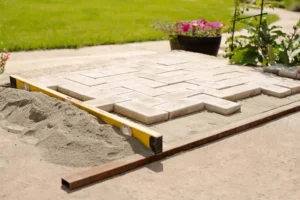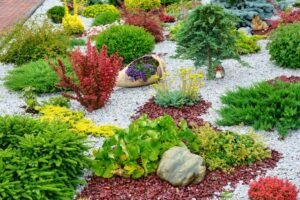A well-maintained irrigation system is the secret to a lush, vibrant lawn. Timely irrigation system repair not only prevents water waste but also saves you from costly damage while ensuring your yard stays healthy all year long. Whether you use sprinklers, drip irrigation, or soaker hoses, knowing how to spot and fix problems early can save you time, money, and unnecessary stress.
In this guide, we’ll dive into the different types of irrigation systems, highlight common issues, and provide easy-to-follow irrigation system repair tips. Plus, we’ll share expert maintenance hacks to help your system run at its best. Ready to boost efficiency, conserve water, and keep your landscape looking stunning? Let’s get started!

Types of Irrigation Systems
Sprinkler Systems
Sprinkler systems are widely used for lawn irrigation, offering an efficient way to water large yards. They use spraying heads to evenly distribute water, mimicking natural rainfall for optimal lawn hydration. Regular maintenance is essential to ensure proper functioning, as issues like broken heads or clogged nozzles can disrupt water flow and efficiency. These systems are highly effective but may require professional setup and periodic adjustments to avoid water waste and maintain performance. Ideal for expansive lawns, sprinkler systems provide convenience and uniform coverage, making them a popular choice for homeowners seeking a healthy and lush landscape.
Drip Irrigation Systems
Drip irrigation systems deliver water directly to plant roots, offering efficient water use with minimal waste. Perfect for gardens, flower beds, and landscapes, these systems maintain soil moisture without overwatering. By using emitters or tubes, they reduce evaporation and runoff, fostering healthy plant growth. However, issues like clogged lines, leaks, or uneven water distribution can hinder efficiency, making regular maintenance essential. Proper installation and routine cleaning can prevent these problems. Drip irrigation conserves water, supports sustainability, and provides an eco-friendly, cost-effective solution for watering plants and crops effectively.
Soaker Hoses
Soaker hoses offer an affordable and efficient way to water your garden. They gradually release water along their length, making them ideal for flower beds, vegetable gardens, and other planted areas. This design helps deliver water directly to the soil, minimizing evaporation and conserving water. However, soaker hoses require regular maintenance, as they can develop leaks or blockages over time due to wear or debris buildup. While these issues are common, irrigation system repair can keep your soaker hose functioning efficiently. By regularly inspecting and cleaning the hose, you can extend its lifespan and ensure consistent, healthy watering for your plants.
Common Irrigation System Problems
Even the best yard irrigation system can face issues. Below are some common problems:
Clogged Sprinkler Heads: Dirt and debris can block the spray, reducing water flow.
Leaking Pipes or Hoses: Cracks or wear in the system lead to water wastage.
Broken Sprinkler Heads: Sprinkler heads can break due to lawnmowers or foot traffic.
Malfunctioning Timers/Controllers: Controllers and valves may fail, disrupting the watering schedule.
Water Pressure Problems: Inconsistent pressure affects the performance of watering systems.
How to Identify Irrigation System Problems
Identifying issues early can prevent costly repairs. Here’s how to spot common problems:
Uneven Watering: Check for dry spots or overly wet areas.
Visible Leaks: Look for water pooling or wet soil near pipes.
Low Water Pressure: Inspect for weak spray from spraying heads.
Controller Issues: Ensure timers are programmed correctly and functioning.
Broken Parts: Examine valve boxes and sprinkler heads for visible damage.
Step-by-Step Guide to Irrigation System Repair
Follow these steps for effective irrigation repair:
Shut Off the Water Supply
Before starting any plumbing repairs, it’s crucial to shut off the main water supply. This prevents water from flowing through the pipes, reducing the risk of leaks or flooding during the process. Locate your home’s main water valve, which is often found near the water meter or where the main line enters the house. Turn the valve clockwise to close it completely. Once shut, open a faucet to release any remaining water pressure in the pipes. Taking this step ensures a safe, controlled environment for repairs and avoids potential water damage to your property.
Inspect for Visible Damage
Inspect your irrigation system carefully for visible damage to ensure it operates efficiently. Look closely at pipes for any cracks or leaks that might cause water loss or reduced pressure. Examine valves to ensure they’re not broken or stuck, as this could disrupt water flow. Additionally, check sprinkler heads for damage, such as chips, cracks, or misalignment, which may affect their spray pattern. Damaged components can lead to inefficient watering, higher water bills, or harm to your plants. Promptly identifying and fixing these issues ensures your system runs smoothly and maintains the health of your lawn or garden.
Clean or Replace Clogged Sprinkler Heads
To address clogged sprinkler heads, begin by turning off the water supply and inspecting the heads for dirt or debris. Carefully remove any blockages using a soft brush or a thin tool like a needle. Rinse the head thoroughly to ensure all obstructions are cleared. Reinstall the cleaned sprinkler head and test the system. If the sprinkler still malfunctions after cleaning, replacement may be necessary. Purchase a compatible head and install it following the manufacturer’s instructions. Regularly checking and maintaining your sprinkler heads prevents clogs, ensuring efficient water flow and proper lawn care.
Repair or Replace Broken Pipes
When a pipe is damaged, assess whether it requires a repair or complete replacement. Start by locating the broken section, ensuring the water supply is turned off to avoid leaks or further damage. For minor cracks, use pipe repair kits or epoxy to patch the area. For severe damage, cut out the broken section and replace it with a new pipe, ensuring secure fittings and seals. Use tools like pipe cutters, wrenches, and adhesive materials as needed. Once fixed, turn the water back on and test for leaks to ensure the repair or replacement was successful.
Fix Water Pressure Issues
Water pressure problems can be frustrating, but they’re often easy to fix with the right approach. Start by checking the valves to make sure they’re fully open. If they’re not, adjust them accordingly. Next, inspect and clean the backflow preventers—clogs in these parts can restrict water flow. Look for visible leaks in pipes or fixtures, as they can cause significant drops in pressure. Don’t forget to check faucet aerators and showerheads for mineral buildup, and clean or replace them as needed. If the problem continues, examine the main water supply line for any obstructions or damage. Regular maintenance and prompt repairs are essential for keeping your water pressure consistent and your system running smoothly.
Reprogram Timers for Optimal Efficiency
Ensuring your irrigation system runs effectively depends on the right settings for the season. Reprogramming your timers is essential, particularly in the spring and summer when plants require more water. Check the controller settings to ensure they match your desired schedule. Adjust the duration and frequency based on factors like soil type, plant variety, and local weather conditions. Regularly reviewing and updating the settings helps avoid overwatering or underwatering, promotes plant health, and conserves water. Stay proactive and adjust as weather conditions change, whether it’s rainfall or drought. Properly programmed timers keep your system efficient and your plants thriving. For expert Bay Area landscape construction and irrigation solutions, Lakota Design Group can help you achieve a well-maintained, eco-friendly system that keeps your landscape flourishing year-round.
When to Call a Professional for Irrigation System Repair
While many repairs can be handled independently, some issues may require professional expertise. It’s time to call in an expert when:
- You have persistent water pressure issues
- There are extensive leaks or significant pipe damage
- You need to replace a large section of your system
- Complex components like the valve box or controllers need repair
A professional can ensure your system is repaired properly, saving you time and future expenses.
Preventative Maintenance Tips for Irrigation Systems
To avoid costly repairs and ensure your irrigation system runs smoothly, regular maintenance is essential. Here are some simple tips to keep your system in top shape:
- Inspect the system every few months
- Clean clogged sprinkler heads regularly
- Replace worn-out parts like hoses and nozzles
- Adjust watering schedules for different seasons
- Winterize your system to prevent freezing damage
Cost of Irrigation System Repair
Understanding the potential cost of repairs helps you plan for maintenance. Here’s an estimate of common repairs:
- Clogged Sprinkler Head: $50–$100
- Leaking Pipes: $150–$300
- Broken Sprinkler Heads: $75–$150
- Timer Repairs: $100–$250
- Professional Services: $200–$500 (depending on damage)
Investing in regular irrigation system maintenance can reduce long-term repair costs and extend the life of your system.
Conclusion
A properly functioning irrigation system is key to keeping your lawn lush and healthy. By understanding the basics of irrigation system repair and addressing issues early, you can avoid costly fixes and keep your system working at its best. Whether you’re replacing a broken sprinkler head, adjusting a timer, or calling in a professional, timely repairs and regular maintenance are essential for a thriving landscape. For top-tier irrigation system repair in the Bay Area, choose Lakota Design Group to ensure your system runs efficiently year-round!





